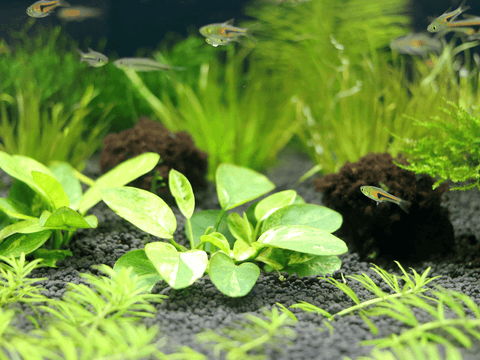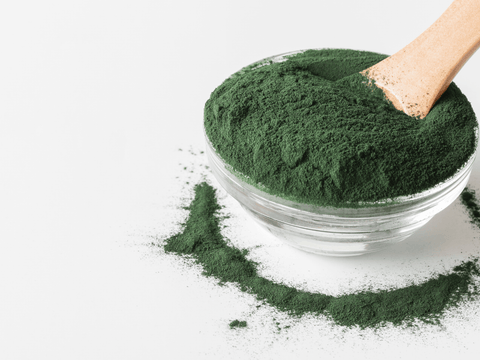An aquarium is not only an impressive home for your fish, but also a small ecosystem that requires careful planning. One of the most important elements that affects the health and well-being of your aquarium inhabitants is the substrate. There are many factors to consider when choosing between gravel, sand and soil. In this blog post, we'll highlight the pros and cons of these different types of substrate so you can make the best choice for your aquarium.
Gravel as a substrate
A popular aquarium substrate is gravel. What the advantages / and disadvantages of gravel as a substrate in the aquarium are, we would like to bring you here very much a little closer.
Advantages of gravel as an aquarium substrate:
Aesthetics: Gravel looks extremely appealing in an aquarium. There is a wide range of colors and sizes to choose from, which allows you to customize the look of your aquarium according to your personal preferences and the theme of the aquarium.
Bacteria colonies: Gravel provides a large surface area for beneficial bacteria that maintain the nitrogen cycle in your aquarium. These bacteria are crucial for converting harmful ammonia into nitrate, which improves water quality.
Plants: Gravel is an excellent substrate for planted aquariums. The roots of aquatic plants can become well anchored in the gravel, which promotes healthy plant growth.
Easy to clean: Gravel allows for easy vacuuming of dirt and debris, making aquarium cleaning less time consuming.
Disadvantages of gravel as an aquarium substrate:
Dirt trap: Although gravel is easy to clean, it tends to trap dirt and food debris between the pebbles, which can lead to increased maintenance.
Not suitable for all fish: Gravel may be unsuitable for some types of bottom-dwelling fish, such as catfish, as they can suffer injuries to sensitive barbels and whiskers.
Anaerobic conditions: Anaerobic conditions can develop in deeper layers of the gravel bed, promoting the formation of harmful hydrogen sulfide gas. This gas can be toxic to fish.
Consider Grain Size: When selecting gravel, make sure the grain size is not too small, as small grains can be easily swallowed and can interfere with your fish's digestion.
Overall, gravel is a versatile and attractive substrate for aquariums, but it does come with some drawbacks. Choosing the right substrate depends on a number of factors, including the type of fish you keep, your aesthetic preferences, and your willingness to perform regular maintenance.
If you choose gravel, it is important to perform regular water changes and cleanings to maintain water quality and ensure that your aquarium provides a healthy environment for your fish and plants. Ultimately, your choice of substrate should fit the needs of your aquarium inhabitants while also meeting your aesthetic preferences.
Sand as a substrate
Sand as an aquarium substrate is becoming increasingly popular. In this section, we would like to take a closer look at the advantages and disadvantages of sand as an aquarium substrate
Advantages of sand as aquarium substrate:
Natural appearance: Sand simulates the natural waters in which many aquarium inhabitants originally reside. This gives the aquarium an aesthetically pleasing and realistic appearance.
Good for burrowing species: Sand is ideal for fish species that like to burrow, such as certain catfish species and shrimp. They can burrow in the sand and find shelter.
No voids: Unlike pebbles or coarse gravel, there are no voids between the sand grains where dirt and food debris can disappear. This greatly facilitates the cleaning of the aquarium.
Plant-friendly: Plant roots can anchor well in the sand. For aquariums that have live plants, sand is an excellent choice.
Natural filtration: Sand provides some mechanical filtration as it traps dirt particles and keeps the water clearer.
Disadvantages of sand as an aquarium substrate:
Difficult to clean: Sand can easily get stirred up when you vacuum the substrate, which can make it difficult to clean the aquarium. You need to be careful not to move the sand too much, as this could disturb your plants or fish.
Limited oxygen permeability: Sand may allow oxygen to pass through more poorly than coarser substrate. This can lead to anaerobic conditions where harmful gases become trapped in the sand.
More expensive than gravel: As a rule, sand is slightly more expensive than gravel or pebbles.
Special preparation: You need to wash the sand thoroughly before adding it to the aquarium to remove excess dust and dirt particles.
Inappropriate for certain fish: Fish that churn the substrate or that tend to swallow it should not be kept on sand, as this can cause digestive problems.
There are both advantages and disadvantages to using sand as an aquarium substrate. It is important to consider the needs of your fish and plants before choosing sand. If you choose sand, be sure to maintain it regularly and keep the aquarium clean to ensure a healthy and beautiful aquarium life. Regardless of your choice of substrate, good maintenance and water quality is critical to the well-being of your aquarium inhabitants.
Soil (aquarium substrate) as a substrate
Soil aquarium substrate, often referred to simply as "aquarium soil," is a specially formulated substrate designed for use in planted aquariums. Unlike conventional gravel or sand, Aquariumsoil is a growing medium that contains important nutrients for aquatic plants. It is usually made of clay minerals and organic materials and can greatly improve the water quality in your aquarium.
The benefits of Soil aquarium substrate
Nutrient-rich: One of the main advantages of aquarium Soil is its nutrient density. It contains nutrients such as nitrogen, phosphorus and potassium, which are essential for the growth of aquatic plants. These nutrients are released slowly and are available to plants for a longer period of time.
Lower pH: Aquarium Soil has the property of slightly lowering the pH of the water. This is beneficial if you prefer plants and fish that require more acidic water.
Improves water quality: The substrate promotes the growth of beneficial bacteria that help break down ammonia and nitrite. This contributes to an overall more stable water quality.
Promoting Root Growth: The loose, granular nature of Aquarium Soil facilitates root growth in aquatic plants. Healthy roots are critical for plants to thrive in the aquarium.
Prevents algae growth: Because aquatic plants tend to grow better in an aquarium equipped with Aquarium Soil, they have better competition from algae. This can help reduce algae problems.
The disadvantages of Soil aquarium substrate
More expensive than gravel or sand
May cause a slight cloudiness in the water initially, but this will subside over time.
Must be used carefully, as it can over-fertilize the water if used excessively.
In the end, the choice of substrate depends on the needs of your fish species and plants, as well as your aesthetic preferences. In some cases, a combination of these substrate types may also be appropriate.
Remember that the care and maintenance of your aquarium, regardless of the substrate you choose, is critical to the health of your aquarium inhabitants.
A well-maintained aquarium not only provides a feast for the eyes, but also a healthy home for your fish and plants.




Comments (0)
There are no comments for this article. Be the first one to leave a message!